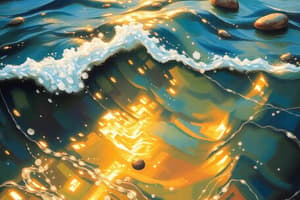Podcast
Questions and Answers
What describes the direction of vibration in a longitudinal wave?
What describes the direction of vibration in a longitudinal wave?
- At right angles to the direction of propagation
- Parallel to the direction of propagation (correct)
- In a circular motion
- Alternating between parallel and perpendicular
What happens to waves when they pass through a narrow gap?
What happens to waves when they pass through a narrow gap?
- They increase in speed
- They reflect back completely
- They lose their energy
- They undergo diffraction (correct)
In the equation $v = f λ$, what does the variable $λ$ represent?
In the equation $v = f λ$, what does the variable $λ$ represent?
- Frequency of the wave
- Amplitude of the wave
- Wave speed
- Wavelength of the wave (correct)
Which of the following is not a characteristic of an optical image formed by a plane mirror?
Which of the following is not a characteristic of an optical image formed by a plane mirror?
How does increasing the wavelength affect diffraction at an edge?
How does increasing the wavelength affect diffraction at an edge?
What is the critical angle in the context of light refraction?
What is the critical angle in the context of light refraction?
Which statement correctly describes the action of a thin converging lens on light?
Which statement correctly describes the action of a thin converging lens on light?
What term describes the ratio of the speeds of a wave in two different regions in refraction?
What term describes the ratio of the speeds of a wave in two different regions in refraction?
What happens to light when it passes through a prism?
What happens to light when it passes through a prism?
How does ultrasound differ from audible sound?
How does ultrasound differ from audible sound?
What characterizes a digital signal compared to an analogue signal?
What characterizes a digital signal compared to an analogue signal?
What is the approximate speed of sound in air?
What is the approximate speed of sound in air?
Which of the following describes total internal reflection?
Which of the following describes total internal reflection?
What determines the focal length of a lens?
What determines the focal length of a lens?
What happens when sound waves travel from air into water?
What happens when sound waves travel from air into water?
What is the primary use of optical fibers?
What is the primary use of optical fibers?
How does an increase in amplitude of a sound wave affect its characteristics?
How does an increase in amplitude of a sound wave affect its characteristics?
What are the traditional components of the visible spectrum in order of frequency?
What are the traditional components of the visible spectrum in order of frequency?
What is the definition of refractive index?
What is the definition of refractive index?
What best describes the relationship between wavelength and wave speed in the equation $v = f λ$?
What best describes the relationship between wavelength and wave speed in the equation $v = f λ$?
In what scenario does diffraction occur based on the size of the gap relative to the wavelength?
In what scenario does diffraction occur based on the size of the gap relative to the wavelength?
Which statement accurately explains the effects of reflection and refraction on waves when they encounter different media?
Which statement accurately explains the effects of reflection and refraction on waves when they encounter different media?
Which of the following describes how transverse waves differ from longitudinal waves?
Which of the following describes how transverse waves differ from longitudinal waves?
What principle describes the bending of waves as they pass from one medium to another with varying speeds?
What principle describes the bending of waves as they pass from one medium to another with varying speeds?
What is the definition of total internal reflection?
What is the definition of total internal reflection?
Which statement accurately describes a virtual image formed by a diverging lens?
Which statement accurately describes a virtual image formed by a diverging lens?
What does a higher refractive index indicate about a medium?
What does a higher refractive index indicate about a medium?
What is the primary factor that determines the bending of light as it passes from one medium to another?
What is the primary factor that determines the bending of light as it passes from one medium to another?
In which circumstance does the critical angle occur?
In which circumstance does the critical angle occur?
Which of the following phenomena demonstrates dispersion?
Which of the following phenomena demonstrates dispersion?
How does the use of optical fibers benefit telecommunications?
How does the use of optical fibers benefit telecommunications?
What happens to sound velocity as it travels through different states of matter?
What happens to sound velocity as it travels through different states of matter?
Which factor primarily affects the pitch of a sound wave?
Which factor primarily affects the pitch of a sound wave?
In which scenario would you expect a sound echo to be perceived?
In which scenario would you expect a sound echo to be perceived?
What is the significance of the principal focus of a converging lens?
What is the significance of the principal focus of a converging lens?
What is a primary disadvantage of digital signals compared to analogue signals?
What is a primary disadvantage of digital signals compared to analogue signals?
Which form of electromagnetic radiation has the highest frequency?
Which form of electromagnetic radiation has the highest frequency?
What is one harmful effect of excessive exposure to ultraviolet radiation?
What is one harmful effect of excessive exposure to ultraviolet radiation?
Flashcards
Wave Speed Formula
Wave Speed Formula
Wave speed (v) is equal to the frequency (f) multiplied by the wavelength (λ).
Transverse Wave
Transverse Wave
A wave where the vibration is perpendicular to the direction of the wave's movement.
Longitudinal Wave
Longitudinal Wave
A wave where the vibration is parallel to the direction of the wave's movement.
Reflection of a wave
Reflection of a wave
Signup and view all the flashcards
Diffraction
Diffraction
Signup and view all the flashcards
Angle of Incidence
Angle of Incidence
Signup and view all the flashcards
Normal.
Normal.
Signup and view all the flashcards
Angle of Refraction
Angle of Refraction
Signup and view all the flashcards
Critical Angle
Critical Angle
Signup and view all the flashcards
Total Internal Reflection
Total Internal Reflection
Signup and view all the flashcards
Refractive Index
Refractive Index
Signup and view all the flashcards
Focal Length
Focal Length
Signup and view all the flashcards
Principal Axis
Principal Axis
Signup and view all the flashcards
Visible Spectrum
Visible Spectrum
Signup and view all the flashcards
Electromagnetic Spectrum
Electromagnetic Spectrum
Signup and view all the flashcards
Ultrasound
Ultrasound
Signup and view all the flashcards
Digital Signal
Digital Signal
Signup and view all the flashcards
Analog Signal
Analog Signal
Signup and view all the flashcards
Wave Speed Equation
Wave Speed Equation
Signup and view all the flashcards
Transverse Waves: Examples
Transverse Waves: Examples
Signup and view all the flashcards
Longitudinal Waves: Examples
Longitudinal Waves: Examples
Signup and view all the flashcards
Reflection of Light
Reflection of Light
Signup and view all the flashcards
Refraction of Light
Refraction of Light
Signup and view all the flashcards
Normal (Light)
Normal (Light)
Signup and view all the flashcards
Refractive Index (n)
Refractive Index (n)
Signup and view all the flashcards
Converging Lens
Converging Lens
Signup and view all the flashcards
Diverging Lens
Diverging Lens
Signup and view all the flashcards
Focal Length (f)
Focal Length (f)
Signup and view all the flashcards
Real Image
Real Image
Signup and view all the flashcards
Virtual Image
Virtual Image
Signup and view all the flashcards
Study Notes
Wave Properties
- Waves transfer energy without transferring matter.
- Wave motion is demonstrated by vibrations in ropes, springs, and water waves.
- Wave features include wavefront, wavelength, frequency, crest, trough, amplitude, and wave speed.
- Wave speed (v) = frequency (f) × wavelength (λ).
- Transverse waves vibrate perpendicular to propagation (e.g., electromagnetic radiation, water waves, seismic S-waves).
- Longitudinal waves vibrate parallel to propagation (e.g., sound waves, seismic P-waves).
- Waves can be reflected, refracted, and diffracted.
- Reflection, refraction, and diffraction are demonstrated using ripple tanks.
- Diffraction depends on wavelength and gap size.
Light Reflection
- Key terms: normal, angle of incidence, angle of reflection.
- Plane mirrors create images that are the same size, same distance from the mirror, and virtual.
- Angle of incidence = angle of reflection.
- Reflection can be analyzed using constructions, measurements, and calculations.
Light Refraction
- Key terms: normal, angle of incidence, angle of refraction.
- Refraction can be observed by analyzing light passing through transparent blocks of different shapes.
- Refraction involves light passing through a transparent material between two boundaries.
- Critical angle is the specific angle for internal reflection.
- Internal reflection occurs when light travels from a denser to a less dense medium.
- Total internal reflection occurs when the angle of incidence exceeds the critical angle.
- Refractive index (n) = speed of light in medium 1 / speed of light in medium 2.
- n = sin i / sin r
- n = 1 / sin c
- Optical fibers utilize total internal reflection for telecommunications.
Thin Lenses
- Converging and diverging lenses affect parallel light beams differently.
- Key terms: focal length, principal axis, principal focus (focal point).
- Ray diagrams show real image formation by converging lenses.
- Image characteristics include size (enlarged/same/diminished), orientation (upright/inverted), and type (real/virtual).
- Virtual images are formed by diverging rays that appear behind the lens.
- Ray diagrams show virtual image formation by converging lenses.
- Single lenses can act as magnifying glasses.
- Lenses correct long-sightedness and short-sightedness.
Light Dispersion
- Light dispersion is demonstrated by the refraction of white light through a prism.
- The visible spectrum has seven colors (traditional order) in frequency and wavelength order.
- Monochromatic light has a single frequency.
Electromagnetic Spectrum
- The electromagnetic spectrum includes radio waves, microwaves, infrared, visible light, ultraviolet, X-rays, and gamma rays.
- All electromagnetic waves travel at the same speed in a vacuum (approximately 3.0 × 108 m/s).
- Various uses tailored for each portion of the spectrum are listed (e.g., radio waves for radio transmission, microwaves for satellite TV, visible light for vision).
- Excessive exposure to certain electromagnetic radiation types can be harmful; specific examples are detailed.
- Microwaves cause internal heating, infrared causes burns, ultraviolet damage cells/eyes, X-rays/gamma rays cause mutations/cell damage.
- Communication with satellites primarily uses microwaves.
- Digital signals offer advantages like faster data transmission and longer range.
Sound
- Sound is produced by vibrating sources.
- Sound is a longitudinal wave.
- Humans can hear frequencies from 20 Hz to 20,000 Hz.
- Sound needs a medium to travel.
- Sound speed in air is approximately 330–350 m/s.
- Sound waves consist of compressions and rarefactions.
- Sound speed is fastest in solids, then liquids, then gases.
- Measuring distance and time can determine sound speed.
- Amplitude and frequency changes affect loudness and pitch.
- Echoes are sound wave reflections.
- Ultrasound is sound above 20 kHz.
- Ultrasound applications include nondestructive testing, medical scanning, and sonar.
Studying That Suits You
Use AI to generate personalized quizzes and flashcards to suit your learning preferences.




